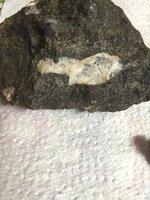Navigation
Install the app
How to install the app on iOS
Follow along with the video below to see how to install our site as a web app on your home screen.
Note: This feature may not be available in some browsers.
More options
You are using an out of date browser. It may not display this or other websites correctly.
You should upgrade or use an alternative browser.
You should upgrade or use an alternative browser.
Got A Rock you Want Identified? Post it here! gimme a good picture or 3 or 4!
- Thread starter Dustedyou
- Start date
Dustedyou
Hero Member
- Dec 27, 2012
- 611
- 399
- Detector(s) used
- Gold Bug, Treasure finder. Gold Cube, Chisel, Hammer, Eye Loop.
- Primary Interest:
- Prospecting
- Thread starter
- #1,263
Serpentine, I've worked with similar material from Afghanistan.
I would actually say petrified wood , with a heavy mineralization, I've found copper, pyrite, opal and other iron mineralizations, causing the same coloration, with spesertine it would come apart in very fiberous sheaths, and would also be very soft.
Great thread! What can you tell me about these? They are from a hillside in Newman Lake, WA. According to my research this is in the Coeur d'Alene area of the Belts Supergroup, which is noted for its quartzite. In particular, the CDA area is noted for a glassy vitreous quartzite. And invisibly fine gold is often found in quartzite. That's all I know, and I don't know if it's right or wrong. The rocks are float, tumbling down the hillside - I haven't found the source yet. Many of them are entirely crystallized, but those that have clustered terminations are stubby and covered in something that looks powdery, but nothing removes the "powder" (not oxalic acid or muriatic acid or sandblasting or water blasting or scrubbing with brass brushes). The white rocks were simmered for days in oxalic acid, then soaked for a few weeks in muriatic acid, trying to make them pretty, but nothing really cleans them up.
So, what can you tell me about these? And might they have that elusive, invisibly fine gold? And how could I tell? And then how could I get it out?
Thanks!!
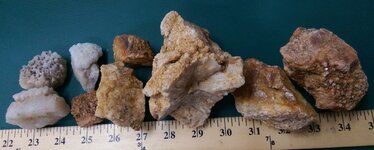
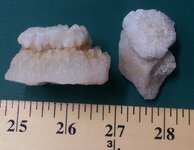
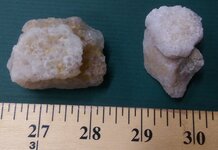
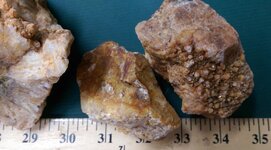
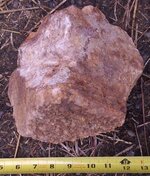
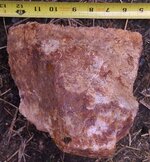
So, what can you tell me about these? And might they have that elusive, invisibly fine gold? And how could I tell? And then how could I get it out?
Thanks!!






Dustedyou
Hero Member
- Dec 27, 2012
- 611
- 399
- Detector(s) used
- Gold Bug, Treasure finder. Gold Cube, Chisel, Hammer, Eye Loop.
- Primary Interest:
- Prospecting
- Thread starter
- #1,265
Great thread! What can you tell me about these? They are from a hillside in Newman Lake, WA. According to my research this is in the Coeur d'Alene area of the Belts Supergroup, which is noted for its quartzite. In particular, the CDA area is noted for a glassy vitreous quartzite. And invisibly fine gold is often found in quartzite. That's all I know, and I don't know if it's right or wrong. The rocks are float, tumbling down the hillside - I haven't found the source yet. Many of them are entirely crystallized, but those that have clustered terminations are stubby and covered in something that looks powdery, but nothing removes the "powder" (not oxalic acid or muriatic acid or sandblasting or water blasting or scrubbing with brass brushes). The white rocks were simmered for days in oxalic acid, then soaked for a few weeks in muriatic acid, trying to make them pretty, but nothing really cleans them up.
So, what can you tell me about these? And might they have that elusive, invisibly fine gold? And how could I tell? And then how could I get it out?
Thanks!!
View attachment 1274299View attachment 1274300View attachment 1274301View attachment 1274302View attachment 1274303View attachment 1274304
Druzy quartz with heavy iron mineralization, when your finding this look also for fluoride, lead,rhodalite and especially for pocketing. This will yield you the best specamines !
Dustedyou
Hero Member
- Dec 27, 2012
- 611
- 399
- Detector(s) used
- Gold Bug, Treasure finder. Gold Cube, Chisel, Hammer, Eye Loop.
- Primary Interest:
- Prospecting
- Thread starter
- #1,266
Also if your looking for the holding will be within the fault that these formed in, depending on the fault I have found that once you start to see minerals that melt at colds temp aka (leadsilverore,copper,fluorite,Rhodalite ,feldspar) this is where you will find gold. Micro or not. An old mine I just visited had mountains of druzy quartz, yet the gold formed close to the lead and copper, 1 to 5 feet in from the face. And the gold is more than visible, it's dreamy. Good luck!
Dustedyou
Hero Member
- Dec 27, 2012
- 611
- 399
- Detector(s) used
- Gold Bug, Treasure finder. Gold Cube, Chisel, Hammer, Eye Loop.
- Primary Interest:
- Prospecting
- Thread starter
- #1,267
Lol and one last p.s. get a loop, a good loop will help you to find most micro gold, don't shy away from fools gold, it contains gold, and can be an amazing way to find a lode, and finally cleaning these rocks is hard, there hard. The black is molybdenum most likely and not much eats it. I suggest a tile saw for cutting them, a textile gun for cleaning them, and a loop for observation! All three should cost no more than 100$ and all three will be worth it.
Lol and one last p.s. get a loop, a good loop will help you to find most micro gold, don't shy away from fools gold, it contains gold, and can be an amazing way to find a lode, and finally cleaning these rocks is hard, there hard. The black is molybdenum most likely and not much eats it. I suggest a tile saw for cutting them, a textile gun for cleaning them, and a loop for observation! All three should cost no more than 100$ and all three will be worth it.
Thanks so much! I'm excited about spring getting here - new exploration and excavation to be done!
So I can cut them with a tile saw? I don't need an expensive lapidary saw?
Eu_citzen
Gold Member
- Sep 19, 2006
- 6,484
- 2,111
- Detector(s) used
- White's V3, Minelab Explorer II & XP Deus.
- Primary Interest:
- Prospecting
I would actually say petrified wood , with a heavy mineralization, I've found copper, pyrite, opal and other iron mineralizations, causing the same coloration, with spesertine it would come apart in very fiberous sheaths, and would also be very soft.
Correct - serpentine would be scratched with a knife. The Fiberous nature of the sheets are not always apparent to the naked eye.
serpentine seems more likely considering cleavage, colour and the fact that he sanded it - which would be easy with serpentines low hardness.
A hardness test might be in order.
Dustedyou
Hero Member
- Dec 27, 2012
- 611
- 399
- Detector(s) used
- Gold Bug, Treasure finder. Gold Cube, Chisel, Hammer, Eye Loop.
- Primary Interest:
- Prospecting
- Thread starter
- #1,270
Thanks so much! I'm excited about spring getting here - new exploration and excavation to be done!
So I can cut them with a tile saw? I don't need an expensive lapidary saw?
Ya harbor freights 30$ tile saw works beautifully, buying a Lapidary saw might come later..lol in my case it did, but the tile saw works the same way the blade is just a wee bit thicker.
Mad Machinist
Silver Member
He's baaaacccckkkk!!!
Remember that rock I found you wanted to see inside of? I got bored and broke it open along the fissures.
Remember that rock I found you wanted to see inside of? I got bored and broke it open along the fissures.
Attachments
Dustedyou
Hero Member
- Dec 27, 2012
- 611
- 399
- Detector(s) used
- Gold Bug, Treasure finder. Gold Cube, Chisel, Hammer, Eye Loop.
- Primary Interest:
- Prospecting
- Thread starter
- #1,273
Omg, nice mineralization of that quartz there, so you bored the cracks? Ya i would look at the fissures but remember that the gold can pool throughout the quartz. Loop and sledge is the way m8! I would also concentrate any bad driver awarness (sledge in hand) toward the copper button area. In green.
Mad Machinist
Silver Member
Or blue peacock there! Very nice!
REM's.
Mad Machinist
Silver Member
Sure looks like copper-minerals and god-knows-what. I hope there's a lot more of that where it came from.
There is. I own the property it came from. A little over a thousand acres with full mineral and water rights.
Dustedyou
Hero Member
- Dec 27, 2012
- 611
- 399
- Detector(s) used
- Gold Bug, Treasure finder. Gold Cube, Chisel, Hammer, Eye Loop.
- Primary Interest:
- Prospecting
- Thread starter
- #1,278
Ok so I finally mounted my Trinitite from Trinity Site white sands missile range. Its glass from the first nuclear explosion. 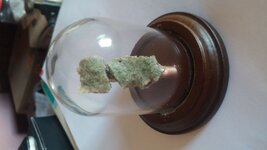
Trinitite, also known as*atomsite*orAlamogordo glass, is the*glassy*residue left on the desert floor after the*plutonium-basedTrinity*nuclear bomb test*on July 16, 1945, near*Alamogordo,*New Mexico. The glass is primarily composed of*arkosic*sand composed of*quartz*grains and*feldspar*(bothmicrocline*and smaller amount of*plagioclasewith small amount of*calcite,*hornblende*andaugite*in a matrix of sandy*clay)[2]*that was melted by the atomic blast. It is usually a light green, although color can vary. It is mildly radioactive but safe to handle.[3][4][5]
In the late 1940s and early 1950s, samples were gathered and sold to*mineral collectorsas a*novelty. Traces of the material may be found at the Trinity Site today, although most of it was bulldozed and buried by the*United States Atomic Energy Commission*in 1953.[6]It is now illegal to take the remaining material from the site; however, material that was taken prior to this prohibition is still in the hands of collectors.

Trinitite, also known as*atomsite*orAlamogordo glass, is the*glassy*residue left on the desert floor after the*plutonium-basedTrinity*nuclear bomb test*on July 16, 1945, near*Alamogordo,*New Mexico. The glass is primarily composed of*arkosic*sand composed of*quartz*grains and*feldspar*(bothmicrocline*and smaller amount of*plagioclasewith small amount of*calcite,*hornblende*andaugite*in a matrix of sandy*clay)[2]*that was melted by the atomic blast. It is usually a light green, although color can vary. It is mildly radioactive but safe to handle.[3][4][5]
In the late 1940s and early 1950s, samples were gathered and sold to*mineral collectorsas a*novelty. Traces of the material may be found at the Trinity Site today, although most of it was bulldozed and buried by the*United States Atomic Energy Commission*in 1953.[6]It is now illegal to take the remaining material from the site; however, material that was taken prior to this prohibition is still in the hands of collectors.
Attachments
Last edited:
llanolargo
Jr. Member
- Feb 29, 2016
- 68
- 25
- Primary Interest:
- All Treasure Hunting
llanolargo
Jr. Member
- Feb 29, 2016
- 68
- 25
- Primary Interest:
- All Treasure Hunting
Top Member Reactions
-
 1899
1899 -
 1057
1057 -
 1005
1005 -
 981
981 -
 865
865 -
 840
840 -
 789
789 -
 744
744 -
 698
698 -
 584
584 -
 366
366 -
 364
364 -
 358
358 -
 345
345 -
 343
343 -
 342
342 -
E
329
-
 312
312 -
 308
308 -
 282
282
Users who are viewing this thread
Total: 2 (members: 0, guests: 2)


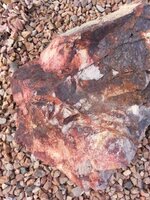
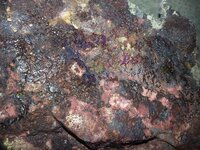
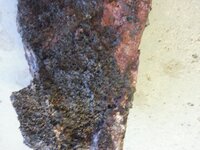
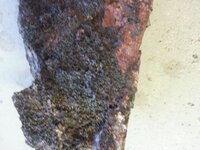
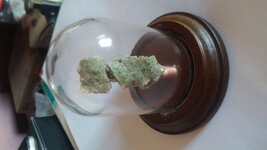
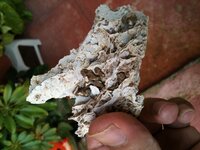
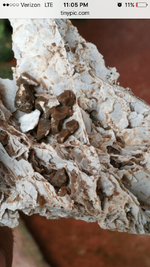
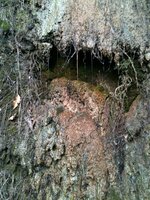
 It came from that hole on the picture,,, when i looked in there a bunchhhhh of flys where inside there where this material
It came from that hole on the picture,,, when i looked in there a bunchhhhh of flys where inside there where this material